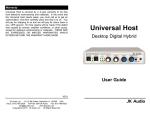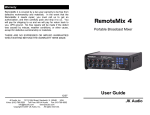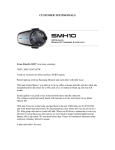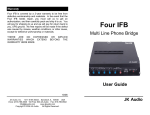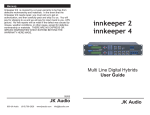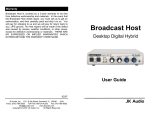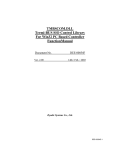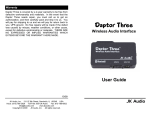Download ComPack
Transcript
Warranty ComPack is covered by a 2 year warranty to be free from defective workmanship and materials. In the event that the ComPack needs repair, you must call us to get an authorization, and then carefully pack and ship it to us. You will pay for shipping to us and we will pay for the return back to you, UPS ground. No free repairs will be made if the defect was caused by misuse, weather conditions, or other cause, except for defective workmanship or materials. ComPack Universal Telephone Audio Interface THERE ARE NO EXPRESSED OR IMPLIED WARRANTIES WHICH EXTEND BEYOND THE WARRANTY HERE MADE. User Guide 03/07 JK Audio, Inc. 1311 E 6th Street, Sandwich, IL 60548 USA Voice: (815) 786-2929 Toll Free: 800-JK-Audio Fax: 815-786-8502 [email protected] www.jkaudio.com Copyright © 2007 JK Audio, Inc. All Rights Reserved. JK Audio FCC Registration (continued) Introduction be unplugged from the modular outlet until the problem has been corrected. Repairs to this telephone equipment can only be made by the manufacturer or its authorized agents or by others who may be authorized by the FCC. For repair procedures, follow the instructions outlined under the warranty section of the manual. ComPack is a universal telephone audio interface that connects to cell phones, PBX phone systems and standard analog phone lines. Perfect for remote broadcasts, IFB feeds, or interviews over any telephone connection. Simply plug your audio equipment into ComPack and connect to a phone line. Then put on your headphones, plug in a microphone and you are ready to broadcast the game or talk up a taped interview. The balanced XLR line output jack provides a high quality connection to mixers and professional tape gear. ComPack also functions as a simple telecom interface for your beltpack intercom system. This no-frills feature allows you to connect the 3 pin XLR to your beltpack intercom group to provide a full duplex, always-on connection to any telephone network. 4. Rights of the telephone company If telephone equipment is causing harm to the network, the telephone company may temporarily discontinue your telephone service. If possible, they'll notify you before they interrupt service. If advanced notice isn't practical, you'll be notified as soon as possible. You'll be given the opportunity to correct the problem, and you'll be informed of your right to file a complaint with the FCC. Your telephone company may make changes in its facilities, equipment, operations or procedures that could affect the proper functioning of your JK Audio product. If such changes are planned, you'll be notified by your telephone company. FCC Part 15 Compliance This equipment has been tested and found to comply with the limits for a Class A digital device, pursuant to Part 15 of the FCC Rules. These limits are designed to provide reasonable protection against harmful interference when the equipment is operated in a commercial environment. This equipment generates, uses, and can radiate radio frequency energy and, if not installed and used in accordance with the instruction manual, may cause harmful interference to radio communications. Operation of this equipment in a residential area is likely to cause harmful interference in which case the user will be required to correct the interference at his own expense. Changes or modifications not expressly approved by JK Audio can void the user's authority to operate the equipment. 2 15 FCC Registration ComPack General Operation Your new JK Audio product has been registered with the Federal Communications Commission (FCC). This product complies with the standards in Part 68 of the FCC rules. 1. Connect your microphone (and/or line input) and headphones to the input and output jacks on ComPack. 1. 2. (a) Connect the jack marked "Phone Line" to any standard analog telephone line, or Connection and use with the nationwide telephone network The FCC requires that you connect this telephone equipment to the national telephone network through a USOC RJ-11C modular telephone jack. (b) Connect the “Wireless Phone Headset Jack” to the 2.5 mm headset jack on your cellular telephone using the supplied cable, or This equipment may not be used with Party Line Service or Coin Telephone Lines. (c) Disconnect the handset on an existing telephone and plug the coily cord from the phone into the “Universal PBX Handset Interface” jack on ComPack. This equipment is hearing aid compatible. 2. Information for the telephone company Upon request from your local telephone company, you are required to provide the following information: a) The "line" to which you will connect the telephone equipment (that is, your telephone number), and b) The telephone equipment's FCC registration number. This can be found on the bottom of your t e l e p h o n e equipment, and, c) The ringer equivalence number (REN) for this equipment. The REN is used to determine the quantity of devices which will be connected to the telephone line. Excessive RENs on the telephone line may result in the devices not ringing in response to an incoming call. In most, but not all areas, the sum of the RENs should not exceed 5.0. To be certain of the number of devices that may beconnected to the line, as determined by the total RENs, contact the local telephone company. 3. 3. Turn on the power switch, flip the phone line switch to dial/talk*, flip the keypad switch to on*, and dial your call. *When using the wireless phone or PBX handset interface, the phone line switch should be left in the Hang Up position and the Keypad switch should be in the off position. All Dialing and answering of calls in these modes must be done from the telephone itself. OR OR Repair Instructions If it is determined that your telephone equipment is malfunctioning, the FCC requires that it not be used and that it 14 2. (a) Standard 2. (b) Cell Phone con- analog phone line nection using wireless phone cable provided 3 2. (c) Handset jack on PBX telephone. Set A-B-C switch for best audio. 6. Phone Mix Output / Intercom Link 8. Keypad On / Off Switch Clip LED 4 JK Audio, Inc. ComPack Block Diagram 1/10/02 - WR 3.5mm Line Input XLR Input mic/line switch 1. Female XLR Input Level Control The Mic Input volume control adjusts the level of audio from the female XLR input. Adjusting this control determines the level of audio you send down the phone line from this input.* There is an LED that will indicate when your audio is clipping so you can decrease your input volume to avoid distortion. *The FCC requires that a limiter be present in any device that connects to a phone line. The peak limiter within the ComPack will help to control the audio level sent down the phone line so it does not exceed the maximum audio level specified by the FCC. 13 1/4" Headphone Jack Hybrid Transformer Intercom LInk Isolation Transformer FCC signal limiter 7. DTMF Keypad 2. 3.5 mm line input level control The Line Input volume control adjusts the level of audio from the 3.5 mm input. Adjustment of this control determines the level of audio you send down the phone line from this input.* Line Output Switch Selects XLR Function DTMF Keypad 5. 9VDC Power Jack 9. Phone Line Switch On Hook / Off Hook Headset Emulator Circuit 10. Power Switch PBX Hybrid Transformer 4. Battery Door Handset Type Switch Ring LED 3. Headphone Level Control Clip LED RJ-22 Handset Jack 2. 3.5 mm Line Input Level Control RJ-11 Phone Line Jack 1. Female XLR Input Level Control 1/4" TRS Cellular Interface Block Diagram Features Specifications Inputs: Female XLR 3.5 mm Outputs: Male XLR 1/4” jack Features 1000 ohms, mic/line switch -35 dB pad Line level, 20k ohms, 250 mV, (-10 dBm) RMS Phone mix mode - balanced 600 ohms, 15 mV, (-25 dBm) RMS intercom mode - bi-directional unbalanced 8 ohms, 500 mW Power: One 9 volt battery or AC power supply (included) Size: 8” x 3” x 2.2” (20.3 x 7.6 x 5.6 cm) Weight: 1.5 lbs. Shoulder strap, wireless interface cable and one 9 volt battery included. 3. Headphone Level Control The headphone volume control adjusts the level of audio sent out the 1/4” headphone jack. Adjusting this control will determine the level of audio you hear in your headphones. 4. Battery Door The easy change battery door can be opened by inserting a small object into the slot, such as a coin or fingernail, and lifting up and out. The battery should be removed if ComPack is not going to be used for extended periods of time. 5. 9 VDC Power Jack ComPack is powered by either one 9 V battery or the included AC adapter. The provided AC to DC adapter is a high quality, regulated power supply. When the power supply is connected to ComPack, battery power is bypassed. This AC adapter is for powering the unit only, it does NOT charge the battery. Make sure to use only the supplied AC adapter with ComPack. Using any other adapter can cause poor audio quality and/or damage the unit. If you need a replacement AC adapter, contact any JK Audio dealer and ask for a 9 V power supply (Part # PS008). 6. Phone Mix Output / Intercom Link This recessed switch sets how the male XLR jack will be used. With the switch to the left (toward the XLR jacks) the XLR jack will contain a mix of the telephone caller and the microphone or line input from the female XLR jack. With the switch to the right (toward the level control knobs) the male XLR will provide bidirectional audio for use with your intercom beltpack system. 7. DTMF Keypad The telephone keypad is equipped for tone dialing only. You may use the keypad at any time during a call but keep in mind that transmit audio is muted during a keypress. This keypad should only be used to dial calls when the unit is connected directly to an analog telephone line. 8. Keypad On / Off Switch This switch disables the DTMF keypad to prevent tones from being blasted down the phone line during a broadcast. You should leave this switch in the off position when using the wireless phone or PBX handset interface. 12 5 Features FAQs 9. ? How can I record my conversation? ! The balanced male XLR, in "Line Out" mode provides a nice mix Phone Line Switch This switch acts as the switch-hook for the telephone line. The Hang Up position is the normal on-hook position when you are not using the line or you are waiting for a call. When you want to place a call, or when a call comes in, switch to the Dial/Talk position. When using the Handset or Wireless Interface, the switch should remain in the Hang Up position at all times. 10. Power Switch The power switch should be left in the “Off” position any time the unit is not being used or battery drain will occur. The unit will retain a phone line connection if the power switch is turned off during a call. 11. Battery Test Button / LED To test the battery, press the Battery Test button on the side of the unit. If the LED lights, the battery is still good. The unit may still function if the LED does not light, but there may be significant audio distortion and a loss of level as the battery continues to discharge. Under normal use you should get at least 20 hours of continuous use from one fresh 9 volt alkaline battery. 12. Wireless / Cellular Telephones ComPack comes equipped with a built in cellular telephone interface. This 1/4” wireless interface jack accepts a special 1/4” to 2.5 mm cable provided with the unit. This interface will work with any wireless phone that can accept a standard 3conductor headset and earpiece. Some wireless telephones have the standard 2.5 mm jack while others have proprietary jacks. Adapters to convert the proprietary jack to the standard 2.5 mm jack are available for most wireless telephones through local electronic stores, their respective telephone dealers or many internet stores. When using the wireless interface, it is important to keep your wireless telephone 12”-24” away from the ComPack and any microphone or headphone cables. This will help prevent unwanted RF noise from entering the unit. 6 of both sides of the conversation. ? What is the Com Link used for? ! Simply slide the Male XLR function switch to Com Link and you can connect the ComPack Male XLR to your single channel beltpack intercom system. ? Can I connect ComPack to a powered beltpack line? ! Yes, the ComPack has a DC blocking cap so it will not be damaged if connected to a powered line, although DC power is not necessary for operation. ? ! I've lost the power supply for my ComPack. I have another power supply that fits from a different product. Can I use this instead? NO! Never use a power supply other than the one that was supplied by your manufacturer. Power supplies are available in either AC or DC output with many combinations of voltage and current. DC supplies carry either positive or negative center pin output and may or may not be regulated. If you connect a negative center pin power supply to a positive center pin jack, it's just like hooking up the battery cables to your car backwards. Obviously you would not want to do this to your expensive audio equipment. Regulation is the tolerance to the specified voltage of your DC power supply. All of our power supplies have low noise 5% tolerance. So our 9V DC power supplies will always output 9 volts +/- 5%, whether you are using no power at all or applying a full load. Most consumer power supplies are not regulated. A non-regulated 9V, 800mA power supply could actually output 16V until an 800 mA load is applied. This could damage your equipment and create a great deal of noise. Also, because there is no standard for the size of your power jack, a 16VAC and a 1.5VDC power supply could both have the same 2.1mm jack. 11 FAQs Features ? How ! do I select which telephone interface to use (analog phone line, PBX, or wireless)? Actually, all three connections are live all the time. Technically, you could connect to all three at once, but since there is no way to equalize levels, this "conference call" might not be the best quality connection. 11. Battery Test Button / LED 12. Wireless Phone Interface Jack 13. 3.5 mm Line Input 14. Male XLR Output / Com Link 15. Headphone Jack ? Will ComPack work with my model ______ cell phone? ! As long as your wireless phone has a 3-conductor, 2.5 mm earpiece jack and accepts a generic 3rd party earpiece or headset, you should be OK. ? Can I talk on my cell phone while I record the call? ! No, most phones detect the presence of anything plugged into the headset jack and immediately disable the phone’s microphone and speaker. ? What if my cell phone does not have a 2.5 mm headset jack? ! Some phone manufacturers and many third parties sell adapters to allow connection of a standard 3-conductor 2.5 mm plug. You can often find these adapters where you purchased your phone, in electronics stores or on the internet. ? Can I send and receive audio at the same time? ! Yes, but whatever audio you send into the ComPack will come back mixed with the caller audio. ? Will ComPack provide phantom power for my mic? ! No, our devices will not provide phantom power. If you are connecting your microphone directly to a ComPack, you should use a dynamic mic. ? ! The output from my Mic is very low but it was fine last week. Check the position of the Mic/Line switch near the Mic jack. This input can be switched to accept a line level signal from a mixer or other equipment. 10 21. Visual Ring Indicator 19. Handset Interface Jack 20. Phone Line Jack 16. Female XLR Input 18. Handset Type Selector Switch 17. Mic/Line Selector for XLR Input The wireless interface on the ComPack works very well with most cellular telephones. However, some wireless telephones generate excessive RF noise which can be can be heard as a “chattering” or “motor boat” sound. The noise from these particular telephones will be unacceptable for most broadcast applications. 13. 3.5 mm Line Input The 3.5 mm input is a mono, line level input. This input can be used at the same time as the XLR input. 14. Male XLR Mix Output / Com Link The Male XLR output can be used in two ways: as a balanced, fixed level mixed mono output or as a bi-directional telecom link for your beltpack intercom system. 15. 1/4” Headphone Jack The headphone output is a 1/4” 3-conductor jack. Both the tip and ring of this jack contain the same audio signal. Either mono or stereo headphones may be used. 7 Features ComPack Telecom / Intercom Link 16. Female XLR Input The female XLR input can be used for either the connection of a dynamic microphone or a line level audio signal such as from an audio mixer. This input can be used at the same time as the 3.5 mm line input. ComPack also functions as a simple “no-frills” telecom link for your beltpack intercom system. ComPack will provide bi-directional audio on pin 3 of the male XLR jack to any industry standard intercom beltpack system. ComPack does not provide power over this XLR jack nor does it require power from the loop. ComPack will not recognize a “call” signal generated by your intercom system and it will not provide one. 17. Mic / Line Selector Switch The Mic / Line Selector Switch determines whether the female XLR is to be used as a mic level or line level input. 18. Handset Type Selector Switch Select the handset microphone type of the telephone that ComPack is connected to when using the PBX handset interface. Trial and error works faster than a chart of handset types, but the following may help: Switch Position A B C Handset Microphone Type Electret Dynamic Carbon 19. Handset Interface If you do not have access to an analog phone line or if the phone system is a digital or analog PBX, ISDN, or key system, you can use the built-in handset interface. Simply disconnect the handset from the coily cord and plug the cord into the Universal PBX Handset Interface jack. Dialing must be done with the existing telephone. Make sure to leave the telephone handset off hook or your call will be disconnected. Do not connect a handset to the ComPack; you must talk through your mic. 1. Slide the Male XLR selector switch to the Com Link position. This recessed switch is located near the power jack. Accessing the switch can be done using a small blade screwdriver, or other such object, inserted into the opening. The left position (towards the XLR jacks) designates Line Output. The right position (towards the volume controls) designates Com Link. The factory default position of this switch is Line Output. 2. Connect your beltpack intercom XLR cable to the ComPack Com Link Male XLR jack. The XLR jack is wired as: Pin 1 = Ground Pin 2 = Com in Pin 3 = Com out 3. Your intercom headset should remain plugged in to your beltpack system, not directly into ComPack. 20. Phone Line Jack Use this jack to connect to standard analog telephone lines or a fax / modem adapter for analog cell phones. A 60” RJ-11 cable is provided with the unit. This jack should not be connected directly to digital PBX or ISDN phone systems. 21. Visual Ring Indicator The Ring LED will flash when there is an incoming call from the phone line. This feature is disabled when ComPack is being used with the handset interface or the wireless phone interface. 8 9








